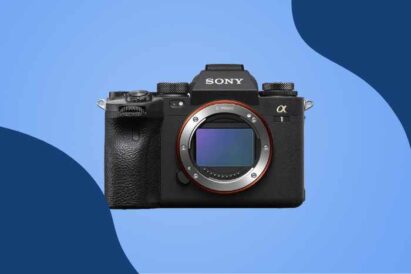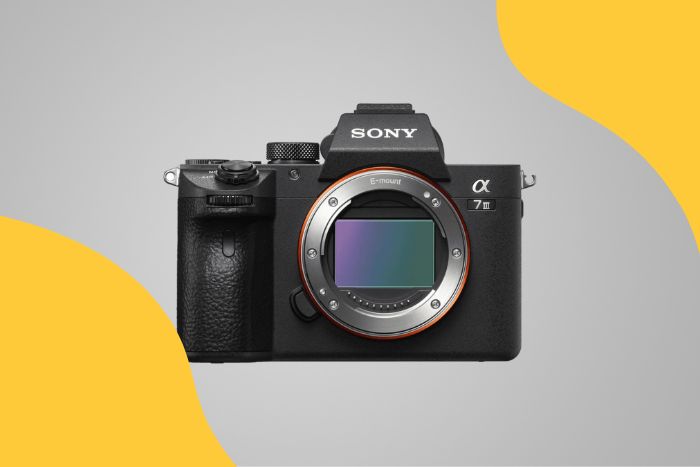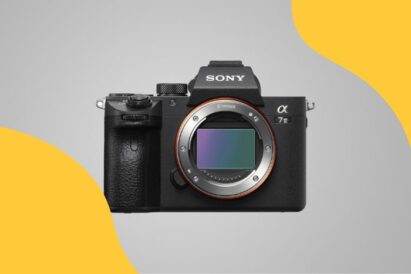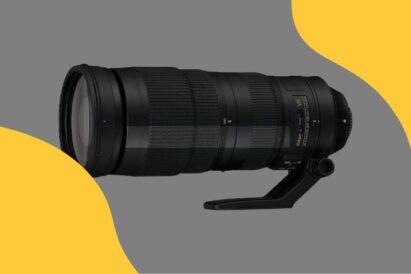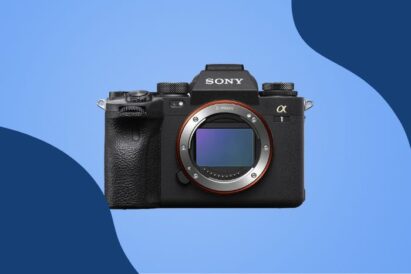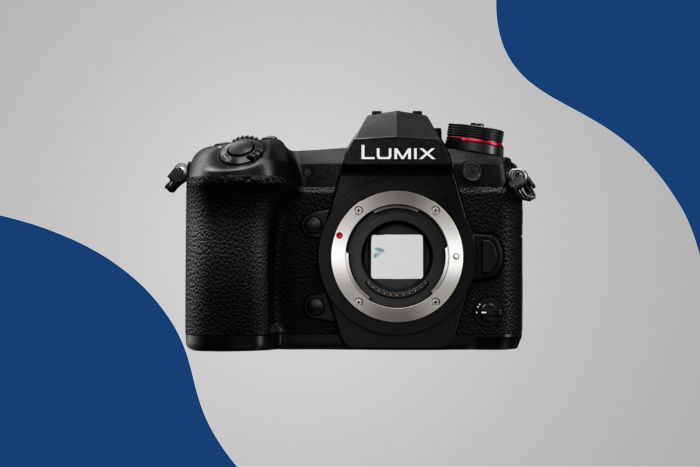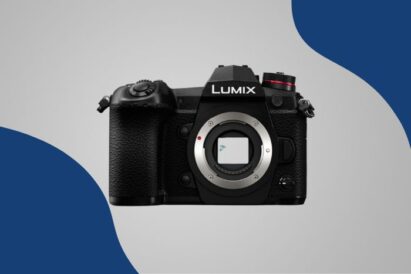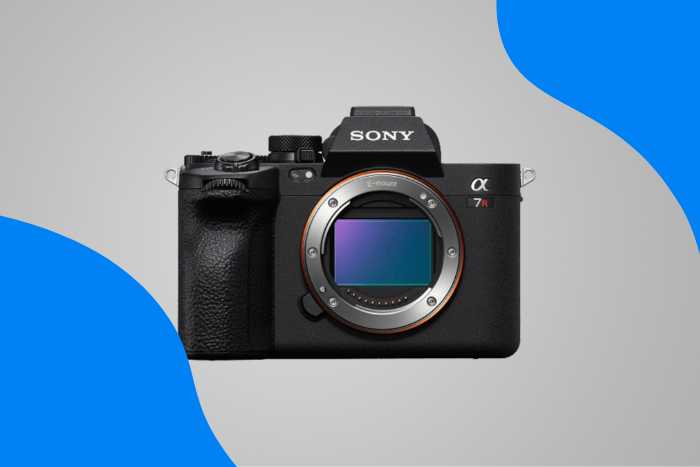Choosing the best camera for product photography depends on your budget and experience. Professional photographers might be able to afford a medium format mirrorless model like the Fujifilm GFX 50S II.
But if you want to take pictures of your own products to advertise on Etsy or Amazon, you could buy a full frame model. Or you could even settle for an APS-C or Micro Four Thirds version.
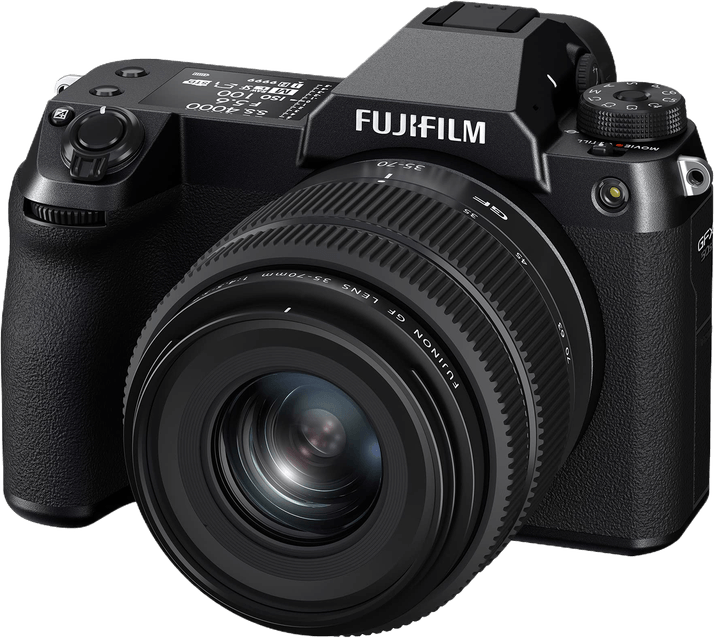
Fujifilm GFX 50S II
What Is the Best Camera for Product Photography?
If you’re looking for the best camera for product photography, there are medium format, full frame, APS-C, and Micro Four Thirds cameras.
You can use them all in tethered mode. And there are both professional and budget options. So there’s something for everyone!
As you go down our list, sensor size and resolution fall along with image quality. And the cameras become much more affordable.

- Fantastic Fujifilm image quality
- 6.5 stops of in-body image stabilization
- Small and relatively light
- Dual-tilt screen for portrait and landscape formats
- Artistic Film Simulation modes
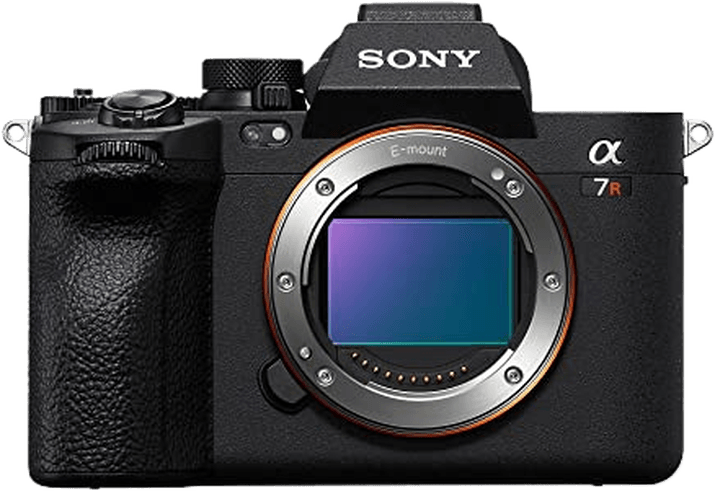
- High-resolution sensor
- Automatic bird or animal eye detection
- Autofocus can track cars, trains, airplanes, and insects
- Big, bright, clear, and sharp electronic viewfinder
- 3.2-inch tilt, flip LCD screen
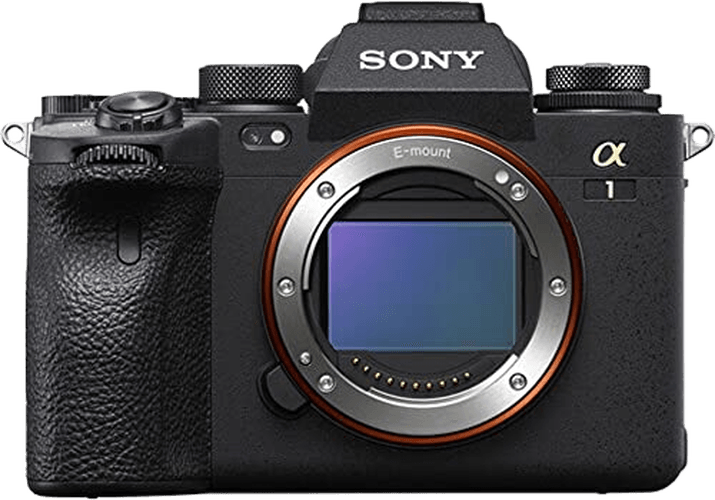
- Large sensor captures tons of detail
- High frame rate of 30 fps
- Eye tracking (human, animal, and bird)
- Easy customization
- Silent shooting for quiet situations
- Incredible 8K/30p Ultra HD video
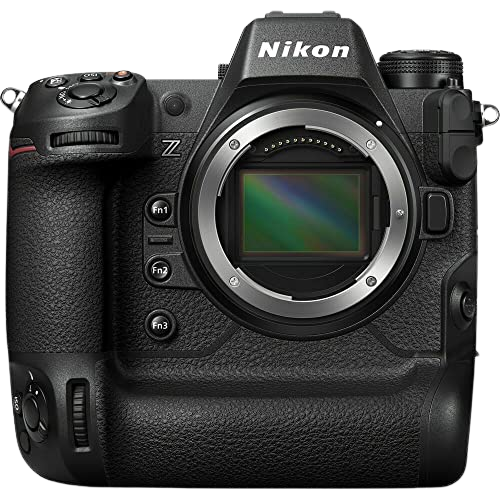
- Ultra-fast image processor
- High, 120 fps compressed frame rate
- No visible rolling shutter
- Excellent battery life
- 8K/60p Ultra HD video
- Unlimited low-resolution recording

- Excellent 20 fps RAW frame rate (120 fps for JPEG)
- 1/32,000 s max shutter speed
- Up to 6 stops of image stabilization
- Deep buffer (1,000 RAW files)
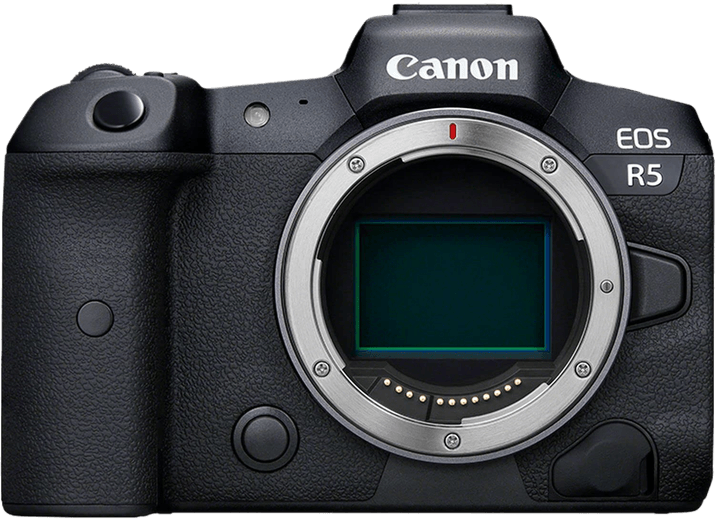
- Large 45 MP sensor
- High frame rate of 20 fps
- In-Body Image Stabilization (IBIS)
- Body, face, eye, and animal tracking
- 8K/30p Ultra HD video
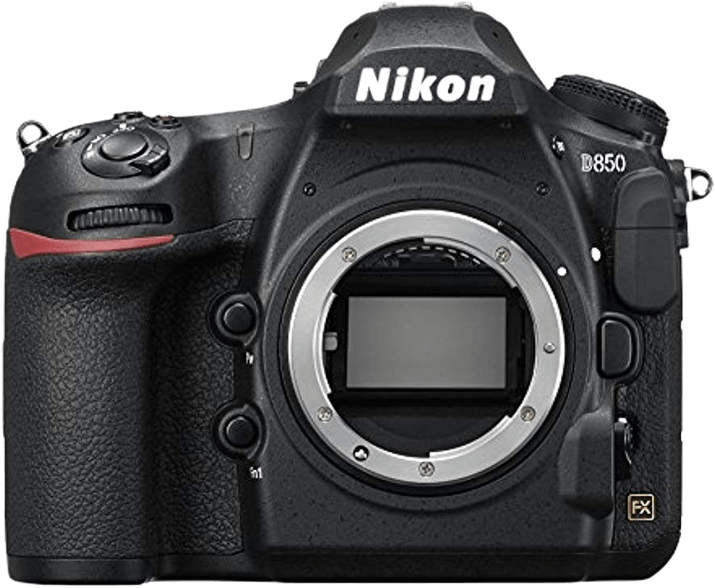
- Fantastic overall image quality
- Excellent 3D continuous AF tracking
- Long, 1,840-shot battery life
- Durable, weather-sealed construction
- Sharp 4K/30p Ultra HD video
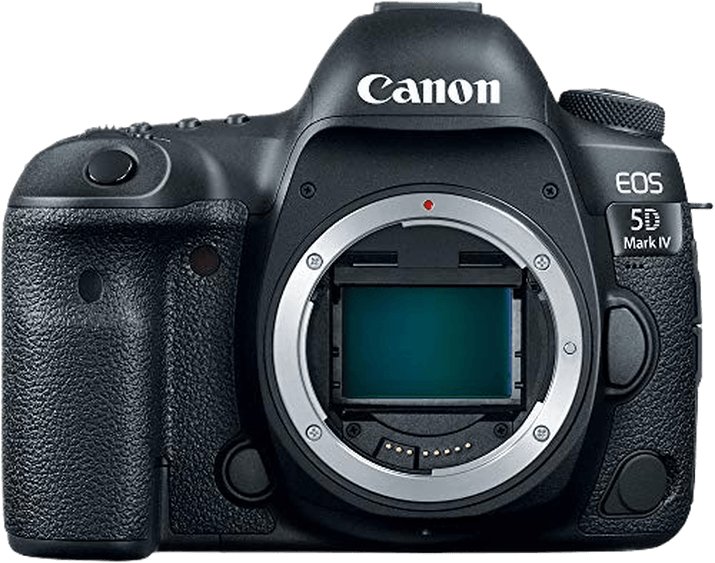
- Quality sensor produces detailed and vibrant images even at high ISOs
- Dual Pixel AF with eye detection
- User-friendly touch-to-focus screen
- 900-shot battery life
- Cinema-quality (DCI) 4K video
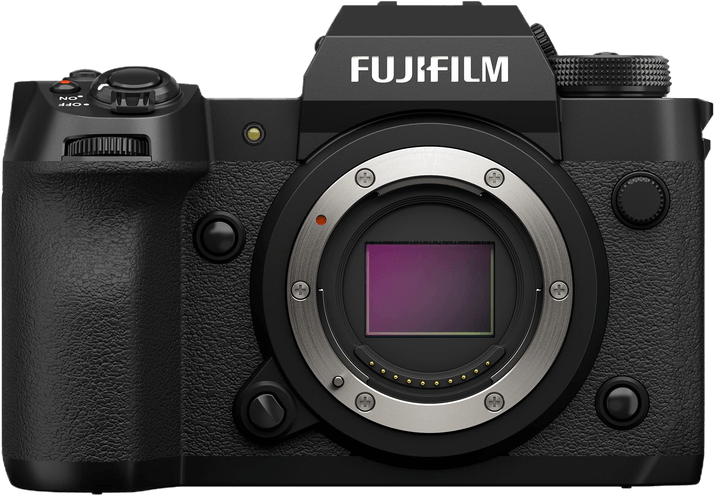
- Powerful 40.2 MP APS-C sensor
- Pixel Shift High-Res mode for 160 MP images
- Built-in 5-axis image stabilization
- 8K cinematic video at 30 fps
- 4K recording at 60 fps and Full HD at 240 fps
- Fully weather-sealed body

- 30 fps burst mode with electronic shutter
- 5-axis sensor-shift image stabilization
- Fully articulating touch screen
- Unlimited, oversampled 4K video
- Animal eye-detect AF for wildlife and pets
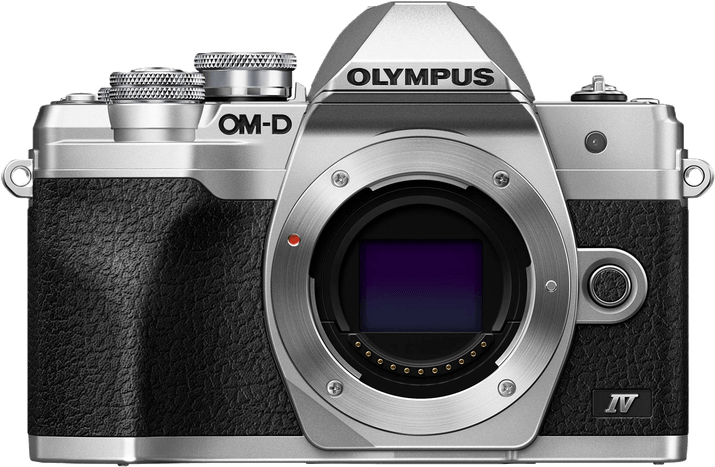
- Affordable
- Very beginner-friendly
- Excellent image quality
- Built-in image stabilization for video and low light
- Endless list of compatible lenses
- Excellent 4K video features
Best Camera for Product Photography (Top 11 in Detail)
Here we do a deeper dive into the specs for each of the best cameras. Use our camera comparison tool as needed.
1. Fujifilm GFX 50S II

| Camera Type |
Camera Type
|
| Megapixels |
Megapixels
51 MP |
| Sensor Format |
Sensor Format
|
| Sensor Size |
Sensor Size
44 x 33 mm
|
| Frame Rate |
Frame Rate
3 fps |
| Autofocus Points |
Autofocus Points
425 |
- Fantastic Fujifilm image quality
- 6.5 stops of in-body image stabilization
- Small and relatively light
- Dual-tilt screen for portrait and landscape formats
- Artistic Film Simulation modes
- Unreliable face and eye detection, unavailable in Continuous AF
- Slow contrast-detect autofocus
- Slow 3 fps continuous shooting rate
- No 4K Ultra HD video
- 16-shot stitching only works with a tripod and static subjects
The Fujifilm GFX 50S II is a 51 MP medium format mirrorless camera that provides excellent image quality. It also features a pixel-shift hi-res mode that can generate 205 MP images!
As with all the mirrorless models on our list, it has in-body image stabilization (IBIS). That gives you a benefit of 6.5 EV (Exposure Value).
The advantage of a medium format camera is that the 44 x 33 mm sensor is 70% larger than a full frame 35mm. This means the pixel pitch is higher.
That leads to roughly two-thirds EV better low-light performance and higher dynamic range. It also allows room for far more pixels, which means greater detail and sharpness.
The microlens design also helps in capturing sharp images. But it sometimes leads to aliasing.
Inevitably, the camera and lenses are bigger and heavier than full frames. But the control layout is similar.
There’s only one dedicated dial that controls the exposure mode. But there are also two custom command dials, front and back.
It leaves space for a large display on the top plate. You can customize it to show the histogram, virtual dials, and other settings.
The rear LCD tilts in two directions to allow portrait and landscape shooting. But the electronic viewfinder (EVF) is a little disappointing, with only 3.69M dots and 0.77x magnification.
The max burst rate of 3 fps is glacially slow. And the autofocus (AF) system is slow and doesn’t have rapid face and eye detection like the latest Sony, Nikon, and Canon mirrorless cameras.
But these aren’t a problem for product photography, which demands single-shot rather than burst shooting. And you have time to focus on your products.
Unlike the GFX 100S, the GFX 50S II can’t shoot 4K video. The highest-quality format is 1080 at 30 fps.
But it does have mic and headphone sockets. And it has Movie Optimized Control to reduce control noise while shooting.
The battery performance is rated at 440 shots per charge, which is fair to middling. And the dual card slots accept SD, SDHC, and SDXC memory cards (UHS-I and UHS-II).
2. Sony a7R V

| Camera Type |
Camera Type
|
| Megapixels |
Megapixels
61 MP |
| Sensor Format |
Sensor Format
|
| Sensor Size |
Sensor Size
35.7 x 23.8 mm
|
| Frame Rate |
Frame Rate
10 fps |
| Autofocus Points |
Autofocus Points
693 |
- High-resolution sensor
- Automatic bird or animal eye detection
- Autofocus can track cars, trains, airplanes, and insects
- Big, bright, clear, and sharp electronic viewfinder
- 3.2-inch tilt, flip LCD screen
- Slow frame rate of only 10 fps
- Focus stacking can't be done in-camera
- No in-camera RAW processing
- May be unbalanced with a big lens
- Rolling shutter effect with 8K video
The Sony a7R V is a 61 MP full frame mirrorless camera. And it’s the best full frame camera for product photography on our list.
It has the latest features to capture stunning photos. These include a multi-shot high-res mode, 8 EVs of image stabilization, an intervalometer, and focus bracketing.
The impressive pixel count lets you capture immense detail in your images. This means your photos will appear sharp and lifelike, showcasing the products in exquisite clarity.
The EVF is a 9.44M-dot OLED display with 0.9x magnification. It’s the same one as in the Sony a1. It offers a crystal clear view of your composition, letting you confidently frame your shots.
The back LCD screen is large and bright. It provides a detailed preview of your images, even in low light. The a7R V beats the a1 in having a fully articulating screen that tilts up and down.
The sensor resolution means the frame rate is limited to 10 fps. But that’s still more than enough for product photography.
The Sony autofocus system is also typically quick and accurate. It ensures your subjects are sharp and focused, even in low light.
The a7R V shines in its video specs, too. It lets you capture high-quality, 8K 10-bit videos at 24 fps (with a 1.24x crop) with superb clarity and smoothness. You also get mic and headphone sockets.
You can take 440 shots per battery charge using the EVF (or 530 with the LCD), providing ample power for extended shooting sessions.
The two memory card slots conveniently take faster CFexpress Type A cards or UHS-I and UHS-II SD cards.
3. Sony a1

| Camera Type |
Camera Type
|
| Megapixels |
Megapixels
50.1 MP |
| Sensor Format |
Sensor Format
|
| Sensor Size |
Sensor Size
24 x 35.9 mm
|
| Frame Rate |
Frame Rate
30 fps |
| Autofocus Points |
Autofocus Points
759 |
- Large sensor captures tons of detail
- High frame rate of 30 fps
- Eye tracking (human, animal, and bird)
- Easy customization
- Silent shooting for quiet situations
- Incredible 8K/30p Ultra HD video
- Expensive
- Highest frame rates only for JPEG, HEIF, and lossy compressed RAW files
- Eye tracking only selected manually
- Small rear LCD screen
- No GPS
The Sony a1 is a 50.1 MP full frame mirrorless camera. I’m a wildlife photographer, and I have a pair of them. And they are the ultimate all-rounders. (Read our full Sony a1 review)
I need its AF speed and accuracy and decent RAW frame rate. But the high-res sensor, 5.5 stops of image stabilization, and bright, clear EVF also help product photographers.
You probably don’t need all the Sony a1’s bells and whistles for product photography. But it’s still one of the most capable cameras—whatever type of photographer you are!
It’s a joy to use, with endlessly customizable controls and an EVF that’s so good it makes you forget you’re not looking at the real world!
But the rear LCD is disappointing. It has a much lower resolution (1.44M dots). It is only three inches across and only tilts up and down.
The 30 fps burst rate is more for wildlife and sports shots than product photography. But the Sony AF system with eye detection and tracking is still probably the best on the market.
One of the other benefits of the high-res, high-speed sensor is that you can shoot video in multiple formats up to 8K at 30 fps and high-speed video up to 240 fps.
The 8K footage comes from the whole width of the sensor. And the readout speed is so fast that there’s negligible rolling shutter. But I’d have liked the option of 4K oversampled video.
According to CIPA figures, battery performance is 430 shots with the EVF or 530 with the LCD. But these figures are vastly understated if you shoot in burst mode.
I once filled up two memory cards on a single charge with the Sony a1. It was over 5,000 images! And like the a7R V, the two card slots take CFexpress Type A, UHS-I, or UHS-II SD cards.
4. Nikon Z9

| Camera Type |
Camera Type
|
| Megapixels |
Megapixels
46 MP |
| Sensor Format |
Sensor Format
|
| Sensor Size |
Sensor Size
23.9 x 35.9 mm
|
| Frame Rate |
Frame Rate
30 fps |
| Autofocus Points |
Autofocus Points
493 |
- Ultra-fast image processor
- High, 120 fps compressed frame rate
- No visible rolling shutter
- Excellent battery life
- 8K/60p Ultra HD video
- Unlimited low-resolution recording
- Only 11 MP files at the highest frame
- You can only shoot RAW files at 20 fps
- Tracking can fail with erratic movement
- IBIS not as good as Canon R3
- Autofocus isn't as good for video
- The screen doesn't fully articulate
The Nikon Z9 45.7 MP full frame mirrorless camera is Nikon’s flagship product. The resolution, AF system, battery life, six stops of image stabilization, and video performance are all excellent.
In fact, there’s not much it can’t do—except shoot at 30 fps like my Sony a1! Again, if you only want a camera for product photography, the Z9 might be overkill.
But it’s good enough in so many ways that you can moonlight as a wildlife photographer without needing another camera!
The Z9 is among the largest and heaviest premium mirrorless cameras. But that’s largely because of the built-in vertical grip.
This makes sense if you like the convenience and extra battery performance. Or if you have large hands!
The 3.69M-dot EVF doesn’t rival the Sony a1’s. But that’s in its own class, so it’s no great loss. You also get a convenient 2.1M-dot 3.2-inch rear screen that hinges vertically and horizontally.
The 20 fps frame rate and AF system are more than enough for product photography. And you’ll never need the absurdly fast 120 fps option (at 11 MP).
You’ll likely be using single-shot most of the time. There’s also no need for the 3D Tracking AF system if you photograph a stationary object in a lightbox! But it does give you options.
If you want to shoot videos of your products, the Z9 is one of the best cameras. You get multiple formats up to 8K. (With 12-bit RAW 8K at 60 fps coming in a firmware update.)
And you can shoot high-speed video up to 120 fps. There’s no recording limit on 4K, and you can shoot up to two hours of 8K footage. You also get headphone and microphone ports.
The battery performance is 700 shots with the EVF (or 740 shots with the rear LCD). This beats the nearest competition on the official CIPA figures.
But even that’s an understatement. You can take up to 5,300 shots when shooting in burst mode.
And you can leave the Nikon Z9 on for around six hours before the battery dies. Plus, there’s also an energy-saving mode that boosts the figures slightly.
Finally, the two memory card slots take XQD or CFexpress Type B cards.
5. Nikon Z8

| Camera Type |
Camera Type
|
| Megapixels |
Megapixels
46 MP |
| Sensor Format |
Sensor Format
|
| Sensor Size |
Sensor Size
35.9 x 23.9 mm
|
| Frame Rate |
Frame Rate
30 fps |
| Autofocus Points |
Autofocus Points
493 |
- Excellent 20 fps RAW frame rate (120 fps for JPEG)
- 1/32,000 s max shutter speed
- Up to 6 stops of image stabilization
- Deep buffer (1,000 RAW files)
- Average battery life
- No in-built vertical grip
- Only one CFexpress memory card slot, the other is SD
- No voice memo feature
The recently released Nikon Z8 45.7 MP full frame mirrorless camera. It is essentially a “baby Z9” and the best all-around Nikon on our list for product photography.
It offers the same sensor, exposure meter, AF system, viewfinder, LCD, and weather sealing as the Z9. But you can get it for less than 75% of the price!
The main difference is in the body. Unlike the Z9, the Z8 doesn’t have a dual-grip design. This makes it about 30% smaller and lighter.
But less real estate on the body means you don’t get one function button, three buttons on the rear, or a drive mode dial on top. You also get only 5.5 stops of image stabilization.
Here are the other differences. (Note that some software features currently missing from the Z8 and Z9 might be added in future firmware updates. One of the joys of mirrorless cameras!)
The RAW frame rate of 20 fps is the same as on the Z9. And the AF system is almost the same. But the Z8 also doesn’t have a LAN-Ethernet port. But you can use a USB-C to Ethernet adaptor.
Another missing feature is the second CFexpress Type B memory card slot. It was replaced by one for an SD UHS-II card.
This might save you money and let you use your existing cards. But it means you won’t maximize the frame rate, buffer depth, and card capacity.
The Z8’s video specs are slightly less impressive than the Z9. You can only record 4K at 60 fps footage for two hours. And there’s a 90-minute limit on 8K at 30 fps.
Battery life is predictably shorter on the Z8, given that it uses a smaller EN-EL15c battery. So you have to replace it after 85 minutes of filming.
And it also means you only get 330 shots with the EVF or 340 with the LCD monitor. This is lower than competitors.
But these CIPA figures assume quite a lot of playback time. If you shoot tethered or review your images on the computer, you can take many more shots per charge.
One small advantage the Nikon Z8 has is that it can save photos in the 10-bit HEIF format. It shows a greater tonal range with compatible HDR devices.
It also has two new features. One is called Portrait Impression Balance to control the hue and tone of the skin. The other is Skin Softening. But it doesn’t have a built-in GPS.
6. Canon EOS R5

| Camera Type |
Camera Type
|
| Megapixels |
Megapixels
45 MP |
| Sensor Format |
Sensor Format
|
| Sensor Size |
Sensor Size
23.9 x 35.9 mm
|
| Frame Rate |
Frame Rate
20 fps |
| Autofocus Points |
Autofocus Points
1,053 |
- Large 45 MP sensor
- High frame rate of 20 fps
- In-Body Image Stabilization (IBIS)
- Body, face, eye, and animal tracking
- 8K/30p Ultra HD video
- Expensive
- Complicated autofocus setup
- Noise reduction applied to RAW files
- Hard to customize
- Overheats shooting video
The Canon EOS R5 is a 44.8 MP full frame mirrorless camera. It is the best Canon mirrorless option on our list for product photography.
It boasts a market-leading eight stops of image stabilization. And the v1.81 firmware update now means it can use pixel-shift image stabilization to generate images up to 400 MP!
But Canon cameras are slightly less advanced than Sony and Nikon models. So you have to choose between speed and resolution.
If you need a fast frame rate, you need the Canon EOS R3. If you’re a product photographer and prefer outstanding image quality and resolution, you need the R5.
The 5.76M-dot EVF only has a magnification of 0.76x. But it comes closest to the a7R V standard. You can also use the 2.1M-dot LCD touchscreen that can be tilted and swiveled in all directions.
The frame rate of 20 fps is more than you’ll ever need for product photography. You also won’t need the eye detection and tracking capabilities of the Dual Pixel CMOS AF II system.
The video specs are excellent. But overheating was so problematic that Canon was forced to release the EOS R5 C with a built-in fan!
The R5 can shoot 8K video at up to 30 fps, either as RAW or H.265 footage. It also offers oversampled 4K footage at up to 120 fps, C-Log, and HDR PQ.
You can also attach headphones and a microphone using the external ports. But like the Z8, the Canon EOS R5 doesn’t have a built-in vertical grip.
Battery life is slightly disappointing at 220 shots per charge with the EVF or 320 with the LCD. And there is one CFexpress Type B memory card slot and one UHS-II SD card slot.
7. Nikon D850

| Camera Type |
Camera Type
|
| Megapixels |
Megapixels
45.7 MP |
| Sensor Format |
Sensor Format
|
| Sensor Size |
Sensor Size
23.9 x 35.9 mm
|
| Frame Rate |
Frame Rate
7 fps |
| Autofocus Points |
Autofocus Points
153 |
- Fantastic overall image quality
- Excellent 3D continuous AF tracking
- Long, 1,840-shot battery life
- Durable, weather-sealed construction
- Sharp 4K/30p Ultra HD video
- No customizable shooting presets
- Slow autofocus in Live View
- Needs an expensive XQD card
- Rolling shutter noticeable in 4K video
- Slow 7 fps or 9 fps with an expensive battery grip
The Nikon D850 is a 45.7 MP full frame DSLR camera. And it’s the best DSLR option for product photography.
I used to have one before switching to a mirrorless. It’s an excellent all-around performer—apart from the frame rate and slow focus in Live View.
With that said, it’s still a DSLR. So you don’t get a mirrorless camera’s focus coverage area or video quality. And there’s no upgrade path!
But the D850 is solid and well-built with a weather-sealed construction. The controls are all where you might expect them to be (as a Nikon user!).
And it has the “widest and brightest” viewfinder of any Nikon DSLR. But the 3.2-inch touchscreen only tilts on one axis. So you can’t use it for selfies or vlogging.
As a wildlife photographer, the frame rate of 7 fps (9 fps with the MB-D18 battery grip) was a major downside for me. In fact, it was one of the main reasons I switched to mirrorless.
But this doesn’t matter at all for product photography. A more important limitation is the AF system. If you use the viewfinder, it’s fine.
But Live View is limited to the slower contrast-detect system. This might slow down your workflow a bit if you prefer to compose your shots on the LCD.
DSLRs generally don’t perform as well for videography, and the D850 is no exception. You can shoot in 4K UHD at up to 30 fps. And there’s even an 8K time-lapse mode.
But there are recording limits of 30 minutes for normal frame rates and just 3 minutes for high-speed video (or 4 GB for both). You also have to use the slower-focusing Live View mode.
You get headphone and microphone ports. Plus, battery life is excellent at 1,840 shots at full resolution or 70 minutes of video footage.
There’s only one slot for the faster XQD or CFexpress Type B cards, though. The other can only take the slower, lower-capacity SDXC, SDHC, or SD cards.
8. Canon EOS 5D Mark IV

| Camera Type |
Camera Type
|
| Megapixels |
Megapixels
30.4 MP |
| Sensor Format |
Sensor Format
|
| Sensor Size |
Sensor Size
24 x 36 mm
|
| Frame Rate |
Frame Rate
7 fps |
| Autofocus Points |
Autofocus Points
61 |
- Quality sensor produces detailed and vibrant images even at high ISOs
- Dual Pixel AF with eye detection
- User-friendly touch-to-focus screen
- 900-shot battery life
- Cinema-quality (DCI) 4K video
- Unreliable, imprecise subject tracking
- Limited dynamic range
- No in-body stabilization
- No bluetooth
- 64x crop factor with 4K video
The Canon EOS 5D Mark IV is a 30.1 MP full frame DSLR camera for enthusiasts. And it is the best Canon DSLR for product photography.
The Mark IV looks very much like the previous version. The viewfinder is large and bright, with 100% coverage and 0.71x magnification.
It has Canon’s Intelligent Viewfinder II. This is an LCD layer that displays selected information in the finder.
There is also a 3.2-inch fixed touchscreen LCD. It lets you select the AF point either before or during filming.
The frame rate of 7 fps matches the D850. But it drops to 4.3 fps in Live View with Servo AF (for moving subjects). And the AF system only has 61 points, 41 of which are cross-type.
The 5D Mark IV‘s excellent Dual Pixel CMOS AF system is available in Live View. It comes with three features:
- Dual Pixel RAW to reduce ghosting and flare
- Image Microadjustment to improve sharpness
- Bokeh Shift to edit camera blur
You can shoot DCI 4K at up to 30 fps with a 1.64x crop or Full HD at up to 120 fps. Various formats are also available, including C-Log video with the C-Log upgrade.
You also get headphone and microphone jacks. Battery life is very good at 900 shots (or 300 in Live View). And there are dual card slots for Compact Flash (CF), SDHC, and SDXC memory cards.
9. Fujifilm X-H2

| Camera Type |
Camera Type
|
| Megapixels |
Megapixels
40 MP |
| Sensor Format |
Sensor Format
|
| Sensor Size |
Sensor Size
23.5 x 15.6 mm
|
| Frame Rate |
Frame Rate
15 fps |
| Autofocus Points |
Autofocus Points
425 |
- Powerful 40.2 MP APS-C sensor
- Pixel Shift High-Res mode for 160 MP images
- Built-in 5-axis image stabilization
- 8K cinematic video at 30 fps
- 4K recording at 60 fps and Full HD at 240 fps
- Fully weather-sealed body
- Expensive for an APS-C camera
- High-res shot mode doesn't always produce the sharpest images
- No shutter or ISO dial on top of the camera
- Certain functions only work with a CFexpress Type B card
- Prone to overheating without additional cooling fan
The Fujifilm X-H2 is a 40 MP APS-C mirrorless camera good for both stills and 8K video. If your product photography budget doesn’t stretch to a full frame camera, this one might be for you!
The X-H2 has a 5.76M-dot EVF with a 120 fps refresh rate and a three-inch fully articulated touchscreen.
There’s no built-in grip. But it can be fitted with the VG-XH battery grip. Or you can add the FT-XH file transmitter grip. This offers better Wi-Fi, an Ethernet connection, and an optional fan unit.
It can shoot at 15 fps. And that rises to 20 fps with the electronic shutter. But the latter means a 1.29x crop.
The AF system has 425 focus points. And if you need eye detection, it works with people and animals.
The X-H2 provides various tracking modes that work well. But the standard AF tracking doesn’t work for video.
You can shoot 8K video, oversampled 4K video at up to 30 fps, or high-speed video at up to 240 fps. Plus, there’s no recording limit. You also get Pro Res, H.264, and H.265 recording options.
You can take 720 shots using the EVF on a single battery charge in economy mode or 580 in normal mode (or 680 with the LCD).
There are headphone and microphone ports. And there are two memory card slots, one for CFexpress Type B and the other for UHS-II SD memory cards.
10. Canon EOS R7

| Camera Type |
Camera Type
|
| Megapixels |
Megapixels
33 MP |
| Sensor Format |
Sensor Format
|
| Sensor Size |
Sensor Size
22.2 x 14.8 mm
|
| Frame Rate |
Frame Rate
15 fps |
| Autofocus Points |
Autofocus Points
651 |
- 30 fps burst mode with electronic shutter
- 5-axis sensor-shift image stabilization
- Fully articulating touch screen
- Unlimited, oversampled 4K video
- Animal eye-detect AF for wildlife and pets
- Fiddly AF joystick and exposure compensation dial
- Easy to change power switch to video by accident
- No built-in flash
- Limited range of native lenses
- Rolling shutter effect shooting video
The Canon EOS R7 is a 32.5 MP APS-C mirrorless model for enthusiasts. It boasts great specs and is the budget Canon option on our list.
It features a Pixel Shift High-Res Mode that can create 160 MP images. Plus, it has focus stacking.
But is sadly waiting for a greater range of native RF-S lenses. In the meantime, you’ll have to make do with full frame RF lenses or EF or EF-S lenses with an adapter.
You can shoot with the 2.36M-dot EVF or the three-inch 1.62M-dot fully articulated touchscreen. And the EOS R7 has a large, comfortable grip.
There’s an upward-facing command dial behind the shutter release and a second vertical dial around the AF joystick on the rear.
This odd layout sometimes means you’ll accidentally change the exposure when moving the AF point!
The 30 fps frame rate is impressive. But the buffer is relatively shallow. So you can’t take long bursts in continuous shooting mode.
The powerful but simple AF system boasts 651 focus points. But you don’t get Eye Control AF as you do on the R3.
The EOS R7 can shoot 4K video at 60 fps with oversampling from a 7K sensor region. This provides excellent detail in combination with the AF and IBIS systems.
You can choose between MPEG-4, H.264, and H.265 formats. The camera also has headphone and microphone jacks. And there are twin card slots for UHS-II SD cards.
According to CIPA, you can take 380 shots using the EVF or 660 with the rear LCD. But the real-world figures should be higher. The limits rise to 500 and 770 shots in power-saving mode.
11. Olympus OM-D EM10 Mark IV

| Camera Type |
Camera Type
|
| Megapixels |
Megapixels
20 MP |
| Sensor Format |
Sensor Format
|
| Sensor Size |
Sensor Size
13 x 17.4 mm
|
| Frame Rate |
Frame Rate
15 fps |
| Autofocus Points |
Autofocus Points
121 |
- Affordable
- Very beginner-friendly
- Excellent image quality
- Built-in image stabilization for video and low light
- Endless list of compatible lenses
- Excellent 4K video features
- Small sensor
- AF has slow continuous shooting
- Contrast-detection AF system is slower than phase-detection systems
- No microphone and headphone jacks
- Plastic body and isn't weather sealed
The Olympus OM-D E-M10 Mark IV is a 20.3 MP Micro Four Thirds camera with a stylish look. And it has a user-friendly interface for beginners with a Live Guide menu.
It also offers dozens of fun Art Filters to play around with. This includes options like Pop Art, Soft Focus, and Bleach Bypass.
The build is a little plasticky. But the camera is small and light with intuitive, dial-based controls.
The viewfinder has 2.36M dots and offers 100% coverage with EVF Auto Luminance to adjust the brightness.
The three-inch, 1.04M-dot, tilting touchscreen can be flipped 180 degrees for selfies and vlogging.
The fastest frame rate is 8.7 fps, and the buffer is deep enough to last until the card is full. The AF system has 121 focus points and offers face and eye detection and focus peaking.
It’s capable of 4K video up to 30p for up to 30 minutes and high-speed video up to 120 fps. The OM-D E-M10 Mark IV has a headphone port but no mic socket.
Battery life is 360 shots with the LCD. And there are two slots for SD or SDHC (UHS-I or II) cards.
Our Verdict
It’s best to consider your particular needs to find the best camera for product photography. Resolution and sensor size are the most important criteria. But your budget may limit options!
Medium format cameras like the Fujifilm GFX 50S II offer image quality, low-light performance, and dynamic range. But there are more affordable options further down our list.

Fujifilm GFX 50S II
The trade-off is smaller sensor sizes and lower resolution. So you’ll have to decide how much you want to spend and the specs you need.
If you’re a professional or want to shoot action photography, choose a medium format or full frame camera.
If you want to take pictures of your own wares to sell online, there’s nothing wrong with an APS-C or Micro Four Thirds model. Otherwise, you might blow your whole marketing budget!
Best Camera for Product Photography FAQs
These are answers to frequently asked questions about product photography cameras. We hope they help clarify any questions you might have to find the best camera.
Which Camera Is Best for Product Photography?
Generally, the best camera has a large sensor and plenty of megapixels. The Fujifilm GFX 50S II is among the best if you can afford a medium format model. Otherwise, plenty of full frame cameras like the Sony a7R V, Nikon Z9, and Canon R5 exist.
The point of adding an image to an online sales page is to show the product in the best possible light. So resolution and detail are the most important criteria.
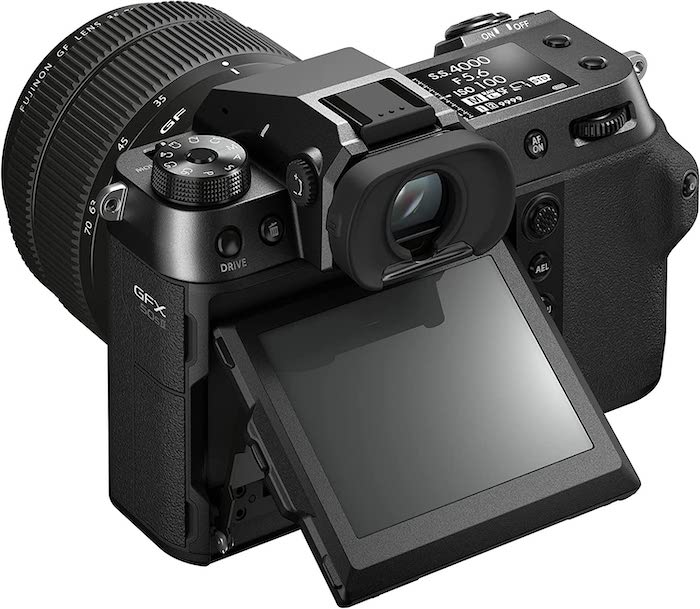
What Is the Best Way to Photograph Products?
Lighting is the most important factor. You really need a two-light set-up or a lightbox to control the conditions. Also, a tripod helps enormously to provide a consistent point of view. After all, you’ll probably be moving and replacing the product rather than the camera!
Do Product Photographers Need Macro Lenses?
Macro lenses are defined as being able to reproduce images at a ratio of 1:1 (or greater). So they’re very handy for product photography. If you get one with a slightly longer focal length (like 105mm), that gives you a little bit more room to work with.



